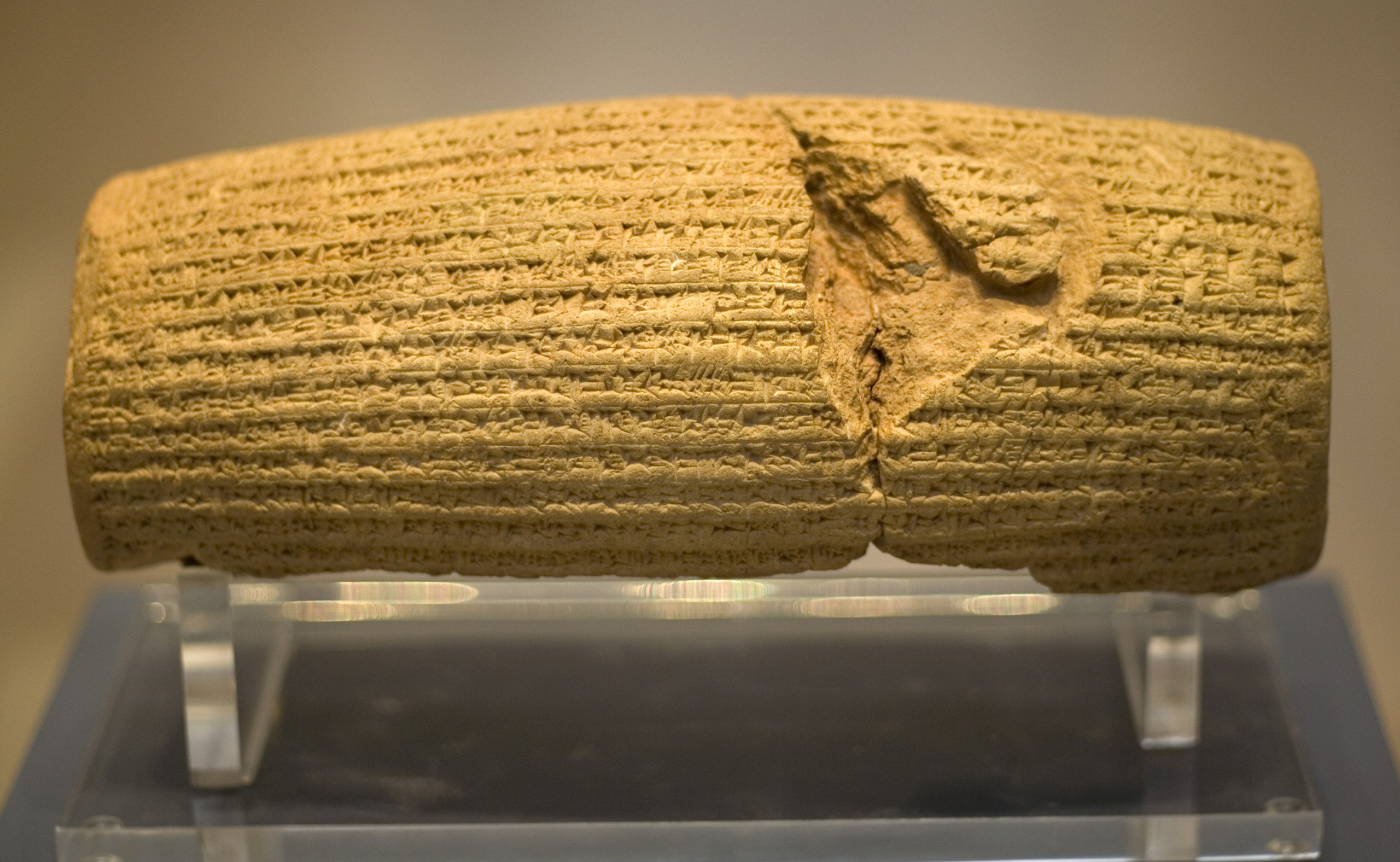The article below is by Mike Boehm and appeared in the Los Angeles Times entitled “Huge significance rolled into tiny Cyrus Cylinder at the Getty Villa” (November 13, 2013). As noted by the Los Angeles Times:
“The cylinder records how Persia’s Cyrus the Great restored justice, peace and piety to Babylon. It’s fabled not for its looks but its historical, political and religious implications.”
Kindly note that the pictures and captions posted below did not appear in the original Los Angeles Times article.
For more on this topic consult:
- Hirad Abtahi: Reflections on the Ambiguous Universality of Human Rights: Cyrus the Great’s Proclamation as a Challenge to the Athenian Democracy’s Percieved Monopoly on Human Rights (pdf)
- Borbor, Dariush (2008). Iran’s Contributions to Human Rights, the Rights of Women and Democracy. Iran and the Caucasus, Volume 12, Number 1, 2008 , pp. 101-121(21).
- Response to Spiegel Magazine’s attack on the Legacy of Cyrus the Great
- Retort to the Daily Telegraph article against Cyrus the Great
- The Cyrus Cylinder, Eleanor Roosevelt & The Universal Declaration of Human Rights
- President Harry S. Truman: “I am Cyrus”
- Dr. Mosi Dorbayani: The Cyrus Cylinder
- Kaveh Farrokh Lecture on Cyrus the Great
- Anti-Iranian Campaign during American Tour and Exhibition of Cyrus the Great Cylinder
=======================================================
The Cyrus Cylinder sits dramatically lighted behind glass at the center of a dimmed gallery at the Getty Villa. But the splendorous setting, including walls painted a deep royal blue, can’t dispel the notion that this may be the homeliest object ever to get star treatment in a major art museum. It’s a 9-inch, straw-colored barrel made of cracked and broken clay, devoid of decorative interest. Horizontally tattooed with row after row of tiny cuneiform script that was etched into it 2,552 years ago, it calls to mind a corn cob that’s been gnawed bare. The conquering Persians who drafted and inscribed the cylinder’s text after they’d taken the fabled city of Babylon in 539 BC did not intend it as any kind of showpiece.
They buried the cylinder inside rebuilt city walls — a customary practice at the time, serving a talismanic function and embedding in Babylon’s very bones a record of how Cyrus the Great restored justice, peace and piety to the capital, which lies south of present-day Baghdad in Iraq. As with the similarly inelegant Dead Sea Scrolls, the Cyrus Cylinder, which was unearthed by an expedition from the British Museum in 1879, is a fabled find because of its historical, political and religious implications rather than its looks. The Getty Villa is the fifth and last stop of a nine-month U.S. tour featuring the cylinder and other ancient Persian artifacts from the British Museum. “The Cyrus Cylinder and Ancient Persia: A New Beginning,” runs through Dec. 8. A second gallery offers 14 artifacts including a gold plaque depicting an ancient Zoroastrian priest and a striking upper-arm bracelet topped by statuettes of winged griffins with the heads of eagles and the horns of goats. But the cylinder is the star, claiming a sizable gallery to itself except for a couple of inscribed ancient clay pebbles that were found elsewhere and echo its text. On a recent weekday afternoon, parties of visitors eagerly stood beside it, posing for pictures. “It’s a very small universe of things that have this status” based only on their inscriptions, said Timothy Potts, the Getty Museum’s director, who has a doctorate in the art and archaeology of the ancient Middle East. The Cyrus Cylinder embodies a great leader’s ideal of prudently humane governance. Having established a multinational empire, Cyrus allowed captive peoples to return to their homelands and worship their own gods. He influenced Benjamin Franklin and Thomas Jefferson, both of whom owned copies of the “Cyropaedia,” an admiring, fictionalized biography and treatise on political philosophy by the Greek soldier and historian Xenophon. The cylinder also evokes a crucial moment for Western religion, because Cyrus’ tolerance gave a new lease on life to Judaism, resolving a crisis in which the Jews had clung to their faith and peoplehood through 50 years of Babylonian exile. The Old Testament’s Book of Ezra and ancient Greek sources recount how Cyrus allowed the Jews to return to Jerusalem with their ransacked ceremonial vessels and encouraged them to rebuild the temple that the Babylonians under Nebuchadnezzar had destroyed. “Without that act, who knows what would have happened?” Potts said — not only to Judaism but also to its eventual offshoot, Christianity. “It can be argued it’s one of those turning points in history that, had it not happened, would have made the history of the world incredibly different.” The Cyrus Cylinder doesn’t mention the Jews, but one of its passages, in a translation by British Museum curator Irving Finkel, is thought to dovetail with and confirm other ancient accounts of Cyrus the Great as their benefactor: “I collected together all of [the displaced groups]… and returned them to their settlements… and made permanent sanctuaries” for gods that the toppled Babylonian king, Nabodinus, had dishonored. For these good deeds, Cyrus prays that “all the gods that I returned to their sanctuaries” will bless him and his successors. The Achaemenid empire, named for one of Cyrus’ Persian precursors, lasted 200 years, stretching eastward at its height from Turkey to the Indus River in what’s now Pakistan until it was overthrown by Alexander the Great in 330 BC. In Southern California, the cylinder’s arrival marks a chance for one of its newest immigrant groups, Iranian Americans, to step forward and counter stereotypes embedded by 34 years of enmity between their homeland’s current regime and the United States. The Cyrus Cylinder “is important because of the ideals it represents, that say who we really are,” said Bita Milanian, executive director of the L.A.-based Farhang Foundation, a nonpolitical, nonreligious organization that aims to further the study and appreciation of Iranian art and culture (“farhang” means “culture” in Persian). Formed in 2008, the foundation has helped establish an Iranian studies program at USC, to go with a long-standing one at UCLA. “Non-Iranians can get to know the Iranian culture and its people in the correct light, rather than the portrayals in the media that we hear every day,” Milanian said. “The exhibition gives us a symbol to point to and start important conversations, to talk about things that have never been public and allow our cultural values to take their rightful place among the highlights and history of civilization.” She estimates that 500,000 Iranian Americans live in Southern California, by far their largest regional presence in the United States, with most having arrived since the 1979 revolution that toppled the shah of Iran and installed the present regime. Milanian said that area school districts’ units on ancient history typically skip Cyrus and the Persian empire, and she hopes that classes coming to see the Cyrus Cylinder will help establish a basis for its eventual inclusion in public school curriculums. Besides the school groups, said the Getty’s Potts, “we’ve had busloads of Persians, and in some cases groups that are Zoroastrians, the same faith as [the Persian Empire’s] rulers. It’s been an extraordinary turnout.”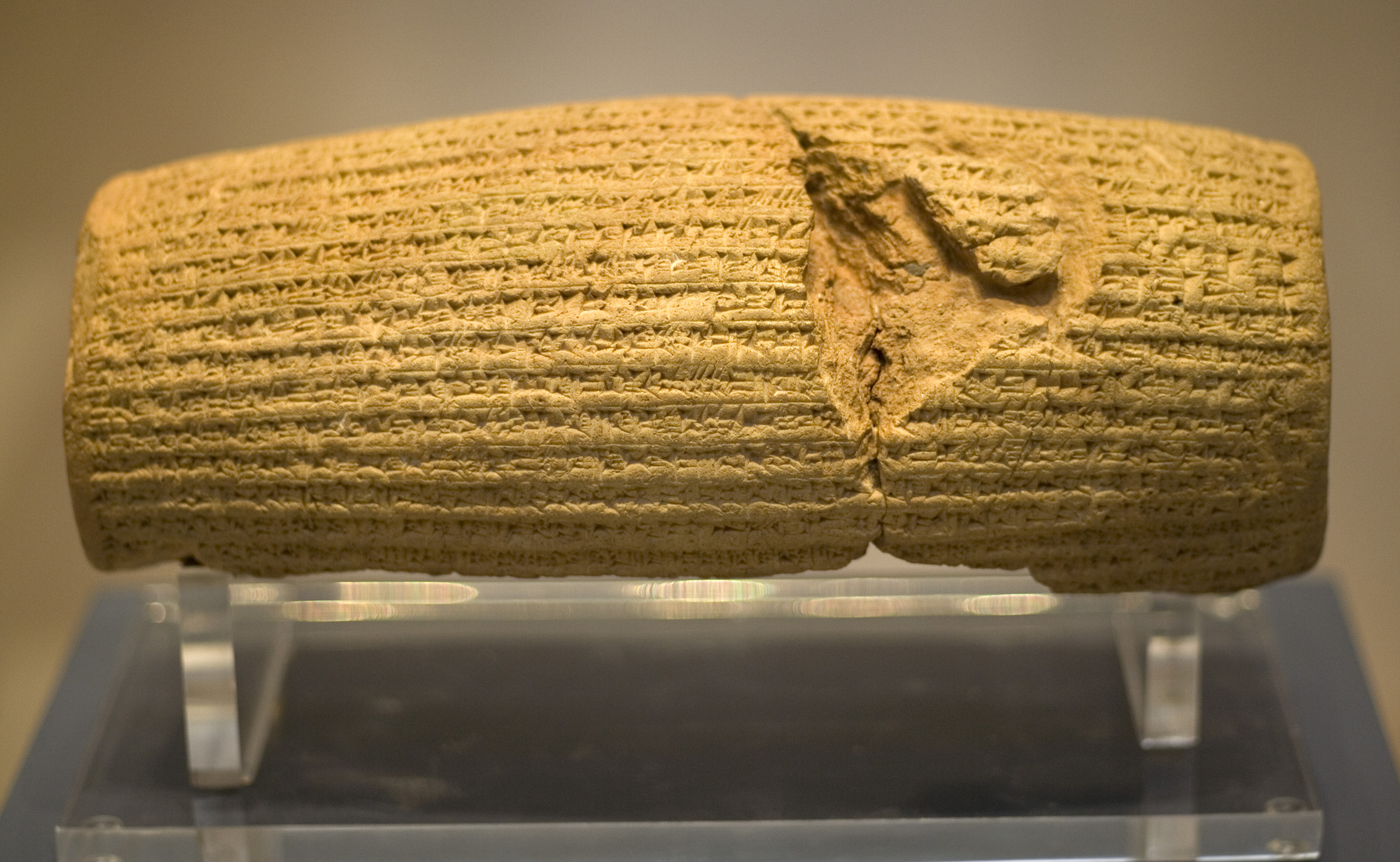
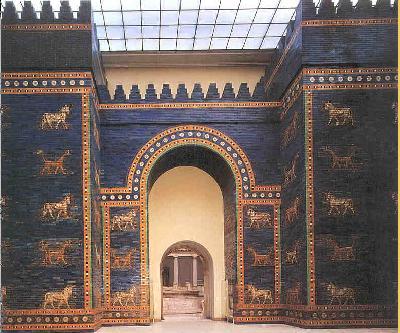 The Ishtar Gate, now housed in the Berlin Museum. When Cyrus entered Babylon-city through the Ishtar gates, the city’s inhabitants laid branches in his path. As noted by Graf, Hirsch, Gleason, and Krefter: “Cyrus proved a tolerant conqueror: when he enteredBabylon…he ordered his troops to show respect for the city’s temples and religious customs.” [D.F. Graf, S.W. Hirsch, K. Gleason, and F.H. Krefter, A Soaring Spirit. New York:Time-Life Books, 1988, p.15]
The Ishtar Gate, now housed in the Berlin Museum. When Cyrus entered Babylon-city through the Ishtar gates, the city’s inhabitants laid branches in his path. As noted by Graf, Hirsch, Gleason, and Krefter: “Cyrus proved a tolerant conqueror: when he enteredBabylon…he ordered his troops to show respect for the city’s temples and religious customs.” [D.F. Graf, S.W. Hirsch, K. Gleason, and F.H. Krefter, A Soaring Spirit. New York:Time-Life Books, 1988, p.15]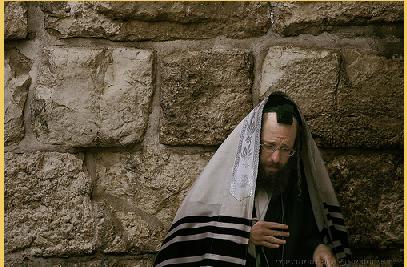 The West Wall in Jerusalem. After his conquest of Babylon, Cyrus allowed the Jewish captives to return to Israel and rebuild the Hebrew temple. It is believed that approximately 40,000 did permanently return to Israel.
The West Wall in Jerusalem. After his conquest of Babylon, Cyrus allowed the Jewish captives to return to Israel and rebuild the Hebrew temple. It is believed that approximately 40,000 did permanently return to Israel.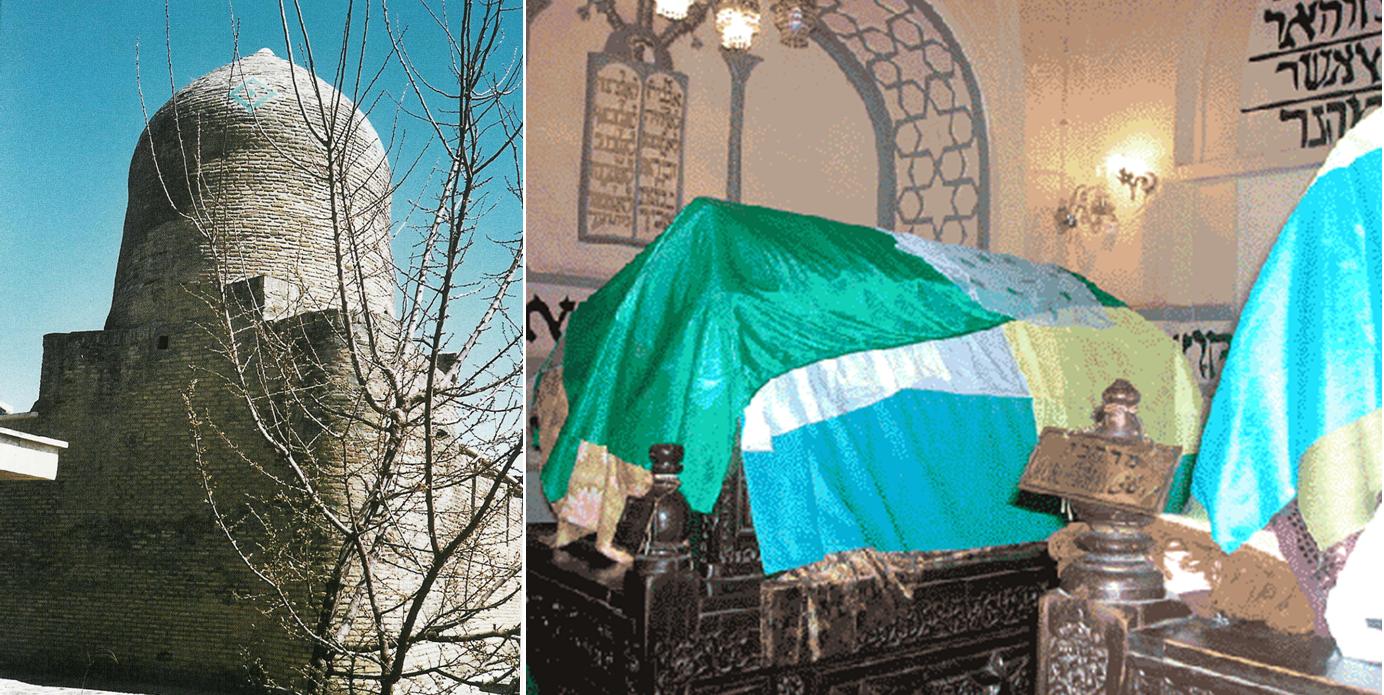 The tomb of Esther and Mordechai in Hamedan, northwest Iran. External view (left) and the interior of the tomb (right).
The tomb of Esther and Mordechai in Hamedan, northwest Iran. External view (left) and the interior of the tomb (right).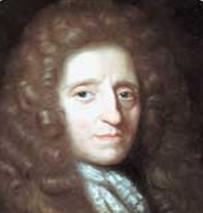 John Locke (1632-1704) is one of the foremost leading thinkers of the enlightenment and one of the proponents of liberal thinking in the western world. He was fully cognizant of the Cyropaedia, which may explain the parallels between his philosophies and elements of Zoroastrian thought followed by Cyrus the Great.
John Locke (1632-1704) is one of the foremost leading thinkers of the enlightenment and one of the proponents of liberal thinking in the western world. He was fully cognizant of the Cyropaedia, which may explain the parallels between his philosophies and elements of Zoroastrian thought followed by Cyrus the Great.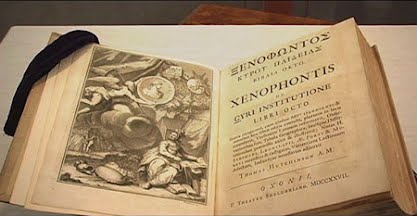 Thomas Jefferson’s copy of the Cyropaedia (Picture Source: Angelina Perri Birney). Like many of the founding fathers and those who wrote the US Constitution, President Jefferson regularly consulted the Cyropedia – an encyclopedia written by the ancient Greeks about Cyrus the Great. The two personal copies of Thomas Jefferson’s Cyropaedia are in the US Library of Congress in Washington DC. Thomas Jefferson’s initials “TJ” are seen clearly engraved at the bottom of each page.
Thomas Jefferson’s copy of the Cyropaedia (Picture Source: Angelina Perri Birney). Like many of the founding fathers and those who wrote the US Constitution, President Jefferson regularly consulted the Cyropedia – an encyclopedia written by the ancient Greeks about Cyrus the Great. The two personal copies of Thomas Jefferson’s Cyropaedia are in the US Library of Congress in Washington DC. Thomas Jefferson’s initials “TJ” are seen clearly engraved at the bottom of each page.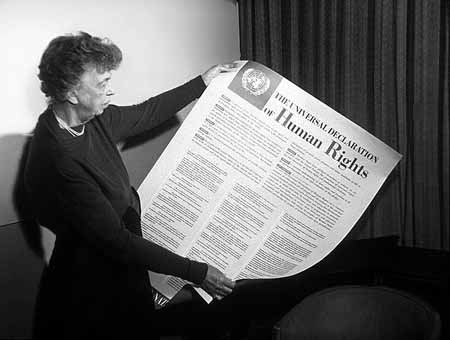 As noted by the United Nations Universal Declaration of Human Rights: “Disregard and contempt for Human Rights have resulted in barbarous acts which have outraged the conscience of mankind, and the advent of a world in which human beings shall enjoy freedom of speech and belief and freedom from fear and want has been proclaimed as the highest aspiration of the common people… All human beings are born free and equal in dignity and rights.” (UDHR-Picture Source: Angelina Perri Birney).
As noted by the United Nations Universal Declaration of Human Rights: “Disregard and contempt for Human Rights have resulted in barbarous acts which have outraged the conscience of mankind, and the advent of a world in which human beings shall enjoy freedom of speech and belief and freedom from fear and want has been proclaimed as the highest aspiration of the common people… All human beings are born free and equal in dignity and rights.” (UDHR-Picture Source: Angelina Perri Birney).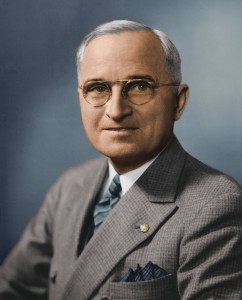 Harry S. Truman (1884-1972) who was President of the United States in 1945-1953. Not only did he acknowledge the legacy of Cyrus the Great in liberating the Jews from their Babylonian captivity, he also stood up against Soviet dictator Joseph Stalin, who tried to absorb Iran’s Azarbaijan province into the Soviet Union. For more Click here…
Harry S. Truman (1884-1972) who was President of the United States in 1945-1953. Not only did he acknowledge the legacy of Cyrus the Great in liberating the Jews from their Babylonian captivity, he also stood up against Soviet dictator Joseph Stalin, who tried to absorb Iran’s Azarbaijan province into the Soviet Union. For more Click here…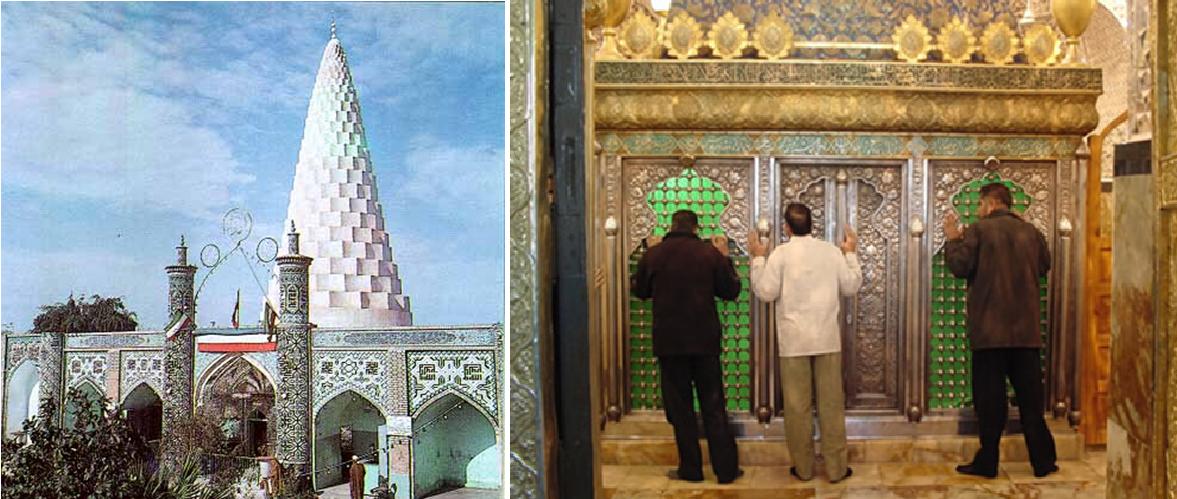 The tomb of Daniel in Khuzestan in southwest Iran. The main structure (note cone-like dome) as it stands today (left) and Iranian pilgrims paying homage within the tomb of Daniel.
The tomb of Daniel in Khuzestan in southwest Iran. The main structure (note cone-like dome) as it stands today (left) and Iranian pilgrims paying homage within the tomb of Daniel.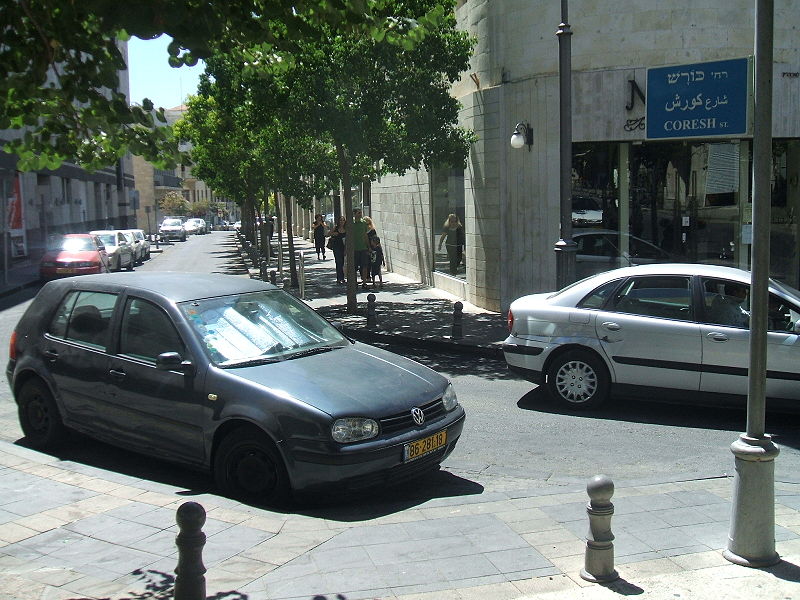 When History goes beyond Politics: Koresh or Cyrus street in Jerusalem. There is currently no street named Cyrus or Koroush in Tehran, the capital of Iran today. There is also an “Iran” street in Israel.
When History goes beyond Politics: Koresh or Cyrus street in Jerusalem. There is currently no street named Cyrus or Koroush in Tehran, the capital of Iran today. There is also an “Iran” street in Israel.

